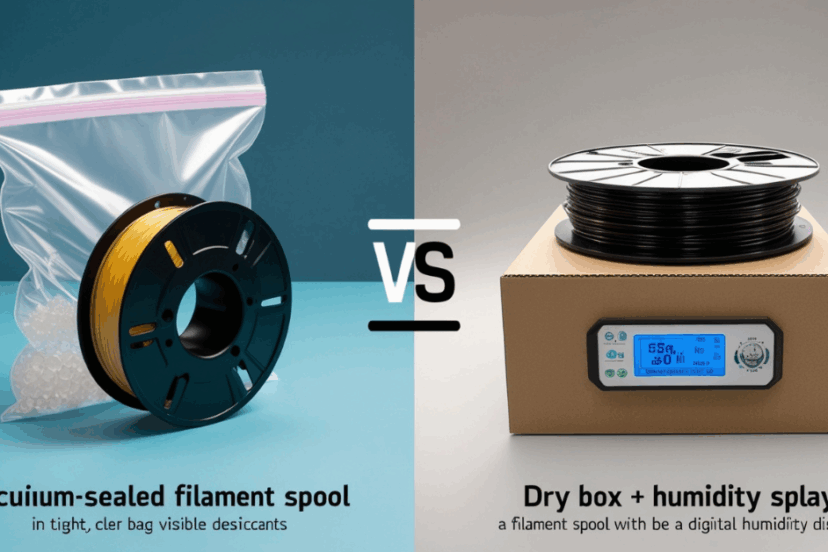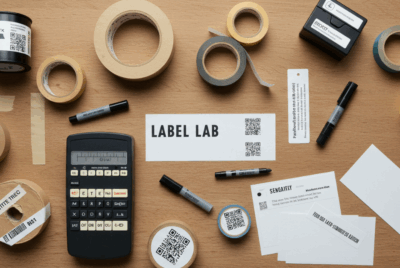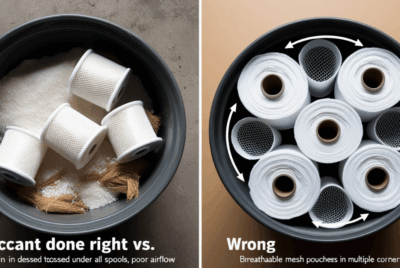How does vacuum sealing compare to dry boxes?
Vacuum sealing and dry boxes are two popular methods for storing 3D filament, each with its advantages and disadvantages. Both methods help protect filament from moisture, but they work in different ways and are suited for different needs. Let’s compare vacuum sealing and dry boxes to help you decide which one is best for your filament storage.
1. Moisture Protection
- Vacuum Sealing:
- How It Works: Vacuum sealing removes air from the storage bag, creating an airtight environment that prevents moisture from entering. Adding desiccants (silica gel) inside the vacuum-sealed bag further helps absorb any residual moisture.
- Effectiveness: Very effective in preventing moisture absorption. By removing air, vacuum sealing eliminates the chance for moisture to come in contact with the filament. It is particularly useful for moisture-sensitive filaments like Nylon, TPU, and ABS.
- Benefit: Ideal for long-term storage, as it keeps filament completely sealed from the surrounding environment.
- Dry Boxes:
- How It Works: Dry boxes are containers that actively control the humidity inside. Some dry boxes have desiccants or built-in heating elements that help maintain a low-humidity environment, and some models can even monitor and adjust humidity levels.
- Effectiveness: Dry boxes are highly effective for keeping filament dry, but their effectiveness depends on the quality and setup of the box. A well-sealed dry box can maintain a constant low-humidity environment, ensuring filament stays dry and free from moisture.
- Benefit: Provides ongoing, active protection against moisture while you are using the filament, making it great for long-term and short-term storage.
2. Convenience and Accessibility
- Vacuum Sealing:
- How It Works: To vacuum seal filament, you place the filament spool in a vacuum bag and use a vacuum sealer to remove air before sealing. It requires an extra step each time you open a new spool.
- Convenience: Once sealed, the filament is compact, but each time you want to use it, you need to reseal the bag after opening, which can be a hassle if you frequently change filaments.
- Benefit: Best for long-term storage since it provides airtight protection, but less convenient for regular access.
- Dry Boxes:
- How It Works: Dry boxes allow you to store filament spools in an accessible, organized manner, with easy access for printing.
- Convenience: Filament can remain inside the dry box and be used directly from it, making it much easier to access and change filaments when needed. Some models even allow you to feed filament from the box into the printer without removing it.
- Benefit: Best for active printing environments since you don’t need to constantly reseal bags or containers after use.
3. Space Efficiency
- Vacuum Sealing:
- How It Works: Vacuum sealing compresses the filament spool, reducing its size. This makes it easier to store multiple rolls of filament in a smaller space.
- Space Efficiency: Highly efficient, as the vacuum-sealed bags can be stacked or stored compactly in small areas. Filament spools take up less space compared to being stored in a dry box or other containers.
- Benefit: Ideal for saving storage space, especially if you have multiple filament rolls to store.
- Dry Boxes:
- How It Works: Dry boxes are typically larger and designed to store one or several filament spools in a more organized fashion.
- Space Efficiency: Dry boxes tend to take up more space compared to vacuum-sealed bags. They are bulkier and require more room for storage, especially if you have multiple spools.
- Benefit: Better for organized storage and active use but less space-efficient than vacuum-sealing.
4. Cost
- Vacuum Sealing:
- How It Works: Vacuum sealing requires a vacuum sealer and sealing bags, along with desiccants if needed.
- Cost: The upfront cost of a vacuum sealer can be a bit high, but the cost of sealing bags is relatively low. Over time, it can be more economical compared to dry boxes.
- Benefit: More affordable in the long run if you’re storing a small to moderate amount of filament.
- Dry Boxes:
- How It Works: Dry boxes are often more expensive, especially if they have built-in humidity controls or heating elements.
- Cost: Dry boxes can have a higher initial cost, especially models with digital humidity control and automatic moisture management systems. The cost can add up if you have multiple boxes for different filament types.
- Benefit: A good investment if you need consistent, active humidity control for a lot of filament.
5. Filament Types and Durability
- Vacuum Sealing:
- How It Works: Vacuum sealing is excellent for moisture-sensitive filaments like Nylon, TPU, and ABS. It helps prevent exposure to air and moisture that can degrade the material over time.
- Durability: The vacuum-sealed bag keeps filament in excellent condition for months or even years.
- Benefit: Best for long-term filament storage and moisture-sensitive filaments.
- Dry Boxes:
- How It Works: Dry boxes are suitable for all filament types, especially those that require a low-humidity environment like Nylon and PETG.
- Durability: Dry boxes provide ongoing protection but are not always as effective for very long-term storage (unless they have integrated features like drying systems).
- Benefit: Perfect for active printing environments and can be used for both short-term and long-term storage as long as the humidity control is reliable.
6. Active Use and Drying
- Vacuum Sealing:
- How It Works: Vacuum-sealed bags don’t allow you to actively use the filament directly from the bag. You’ll need to open the seal to use it, and once opened, you’ll need to reseal it afterward.
- Active Use: Not as convenient for active use since you’ll need to unseal the bag every time you want to print with the filament.
- Benefit: Best for long-term storage but not ideal for frequent access or printing.
- Dry Boxes:
- How It Works: Dry boxes can be used continuously while you print. Some dry boxes even allow you to feed filament directly from the box to your printer without removing it.
- Active Use: Perfect for active use, as you can easily access and use the filament without needing to reseal or remove it from the storage container.
- Benefit: Ideal for active 3D printing setups where filament needs to be accessed and used regularly.
Summary Comparison: Vacuum Sealing vs. Dry Boxes
| Feature | Vacuum Sealing | Dry Boxes |
|---|---|---|
| Moisture Protection | Excellent (airtight environment) | Excellent (active humidity control) |
| Convenience | Requires resealing after each use | Convenient for regular use, no need to reseal |
| Space Efficiency | Highly space-efficient, compact storage | Less space-efficient, bulkier storage solution |
| Cost | Lower cost in the long run | Higher initial cost, especially with advanced models |
| Filament Types | Best for moisture-sensitive filaments | Suitable for most filament types, especially moisture-sensitive |
| Durability | Great for long-term storage | Suitable for both long-term and active use |
| Active Use | Not ideal for active use, requires resealing | Ideal for active use, allows filament to be fed directly from the box |
Conclusion:
- Vacuum Sealing is ideal if you want long-term storage, space efficiency, and effective moisture protection, especially for filaments that are highly sensitive to humidity. However, it requires resealing after each use, which can be inconvenient for active printing.
- Dry Boxes are better suited for active printing environments, where you need easy access to filament and consistent humidity control. They are also more convenient for ongoing use but take up more space and can be more expensive.
Choosing between the two depends on your specific needs: if you’re focused on long-term storage and moisture protection, vacuum sealing is a great option. If you need consistent moisture control for daily use and easy access to your filament, a dry box is likely the better choice.




